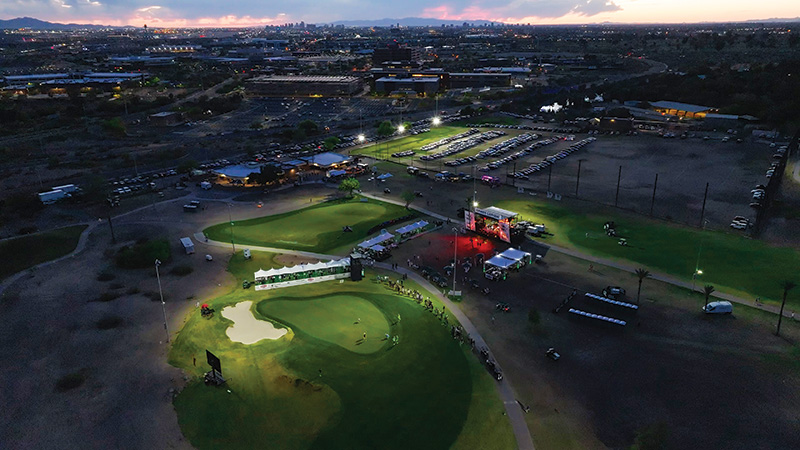
Director of Agronomy Scotty Hebert is loving the night life golf at Grass Clippings Rolling Hills in Arizona. Photos by Alex Johnson
It may not appear to be a big deal to loft a golf shot and eyeball its flight. To Kevin Unterreiner, it was quite the sight on this night.
That’s right. Night.
Twelve months ago in December 2023, night golf was introduced in Arizona at Grass Clippings Rolling Hills in Tempe. The municipal facility flipped the switch as the state’s first fully lit 18-hole golf course that serves by day as an 18-hole executive golf course and 18-hole par-3 course at night. Unterreiner is among those who gave it a try in January.
He traveled quite a way to witness it. Owner of TwinCitiesGolf.com and based in Minnesota, he brought a group of people to witness and play Grass Clippings Rolling Hills, and it didn’t disappoint.
“Night golf is just a different experience. But it’s cool,” Unterreiner says. “Poles shine light upward, and you can see the flight of your ball tee to green. White balls on a dark sky — it’s just a unique experience.”
No wonder this facility’s mantra is “stay grassy.”
Scotty Hebert, the man who wears the boots on the ground and who stepped onto the cutting-edge venture at Grass Clippings Rolling Hills, has been front and center in the transition of a significant overhaul. Hebert has experienced golf in his past in the Valley of the Sun and enhanced his career at rather familiar places, such as Congressional Country Club in Bethesda, Md.; Quail Hollow Club in Charlotte, N.C.; and Sahalee Country Club in Sammamish, Wash. Hebert, a 10-year GCSAA member, has been there, done that in the industry. Overseeing night golf, though, was a sight-unseen challenge. In this past year, he’s embraced it, been tested by it and now even revels in it.
“It’s the biggest fixer-upper possible,” says Hebert, director of agronomy. “Things have fallen into place. It’s a very happening place.”

Seventy-eight LED light banks allow golfers to play night (above) and day at Grass Clippings Rolling Hills in Tempe, Ariz.
Scotty surfaces in the desert
Rolling Hills Golf Course opened with nine holes in 1958. The second nine was added in 1987. By day, it is a 3,428-yard par 59 with some par 4’s. By night, it’s all par 3, measuring 2,712 yards (ranging from 100 to 200 yards) and par 54, with 78 LED lights to illuminate the layout and synthetic tees used seasonally to alleviate excessive amounts of play.
Tee times begin at 7 a.m. and go until the final night par-3 tee time at 11 p.m. The facility is mere minutes from Arizona State University and Phoenix Sky Harbor International Airport and is clearly visible on the flight in. Play is brisk from November through June, up to 330 rounds daily, including at night. “It’s a ton of golf,” Hebert says.
Grass Clippings became part of this equation in 2018. Initially, it was founded as a Phoenix-based modern golf brand that included the sales of T-shirts and hats. Five years later, Grass Clippings agreed to a 30-year lease with the City of Tempe to renovate and revitalize the 93-acre, city-owned golf course. Grass Clippings’ unique brand and fresh take on golf is backed by Scottsdale, Ariz.’s, Troon Golf.
Hebert came aboard in July 2023 and executed a four-month renovation project with golf course architect Jackson Kahn Design. The construction and renovations completed by Casa Verde Golf feature a newly designed ninth hole, additional tee boxes and a 15,000-square-foot practice putting green.
Hebert had spent the previous four years as the senior assistant at TPC Scottsdale, host to the annual WM Phoenix Open on the PGA Tour. Golf is in his family’s fiber. His father, Rich, played in the 1967 U.S. Amateur and 1980 NCAA for Kenyon College. As for Scotty, he received his B.S. from Randolph-Macon College for history and environmental science and started his career in environmental construction, rebuilding streams and wetlands throughout the Mid-Atlantic. Eventually, golf drew him back to that life. His mother’s family operates The Brick Companies, whose portfolio includes Queenstown Harbor and The Golf Club at South River. Growing up on golf courses near the Chesapeake Bay has had a profound impact on his career goals.
The allure of what was on the horizon at Grass Clippings Rolling Hills led him there. He felt his pedigree of working at and for some of the top superintendents in the business prepared him for this.
Keith Wood, GCSAA Class A director of green and grounds at Quail Hollow Club, can attest to it.
“He came here for a fellowship, for a little over a year, including management training, how to put people in a spot to succeed. He’s just very smart. He had a good head on his shoulders, could make decisions, always asked appropriate questions at appropriate times,” says Wood, a 28-year GCSAA member who will host the PGA Championship in 2025. “It’s good when people pay attention to details. He was able to process things, take the next step. Some people just have an eye for detail, work ethic it takes, make the right decisions. Scotty has all that.”

The fun at Grass Clippings Rolling Hills doesn’t end when the sun sets.
What a difference a year makes
Changes have been abundant over the past 365 days since Grass Clippings Rolling Hills flipped on the lights to include night golf, which has caught on in America and abroad. According to GolfLink earlier this year, the Arizona course is one of 22 lighted facilities in the U.S. Overseas, it was reported a few years ago that South Korea had 117 courses that offered night golf.
In March at Grass Clippings Rolling Hills, a significant moment occurred. That’s when Grass Clippings committed financial support to the GCSAA Foundation, the philanthropic organization of GCSAA, to fund the GCSAA Legacy Awards. The GCSAA Legacy Awards competition offers education aid to the children and grandchildren of GCSAA members through $1,500 scholarships. “Grass Clippings is profoundly honored to express our commitment to nurturing the future of golf by supporting its very foundation — the grass beneath our feet and the dedicated individuals who keep it green,” says Jake Hoselton, Grass Clippings co-founder and CEO who launched the business with Jimmy Hoselton, Connor Riley and Pete Wilson.
GCSAA CEO Rhett Evans added, “Grass Clippings has a deep understanding of the essential role superintendents play in the game of golf, and we thank them for their support of our members and their families through the Legacy Awards.”
Also, the golf shop was renovated. Toptracer driving range is available. To accommodate more patrons, the parking lot was revamped, and additional spaces were created. A new restaurant is in the works for 2025.
Hebert certainly has been working it. For the first time in several years, the course was aerified in July 2023. “We are able to be pretty aggressive,” Hebert says of tending to the course’s 328 bermudagrass greens, and those practices, he says, improved plant health and course conditions significantly. Removal of 13 acres of turf in non-play areas was an integral part of his water-conservation plan. A 5.5-acre Sonoran wash restoration project is currently the focal point of Hebert’s sustainability efforts. “Doing this work is very near and dear to my heart,” he says.
Turf reduction in the desert also has been a priority for Hebert, and it has everything to do with water use. “It (water) is a precious commodity out here,” says Hebert, noting the course was closed for the month of October this year for overseeding. “It’s so high in sodium and bicarbonates.” According to Hebert, improving water quality and optimizing its use, while reducing the amount of irrigated turf, is a key part of his plan.

During the month of October, the course is closed for overseeding. The maintenance team works under the lights into the night to make sure the course is ready for play by month’s end.
Coming attractions
“Come one, come all” might as well be the theme at Grass Clippings Rolling Hills.
“All walks of life,” Hebert says. “Groups of young ladies, dads after their kids have gone to bed, bachelor parties. The lights have been a big, big thing for this community.”
The Grass Clippings team also has plans to implement junior golf programming that will extend access to the golf course and venue to a diverse community of young golfers.
And something big happens this month. In what it calls the world’s first high-stakes par-3 golf league that uniquely embraces both professional and amateur events in a team-based format, The Troon Access Grass League Championship is slated for Dec. 5-6. Grass League events are set on the lighted par-3 courses, with the flagship host site located at Grass Clippings Rolling Hills. The Grass League welcomes qualifiers, encouraging broad participation and discovery of emerging talents. With teams divided by regional markets, the league drives a sense of rivalry and community involvement. This approach to team ownership and competitive play marks an exhilarating new chapter in the world of golf, the Grass League says.
For Hebert, the event is another avenue to garner attention to his workplace, which is doing its part to help golfers see the light.
“The past year has been a lot of hard days. Hardest job I’ve ever had,” Hebert says, “and the most fun I’ve ever had.”
Howard Richman (hrichman@gcsaa.org) is GCM’s associate editor.